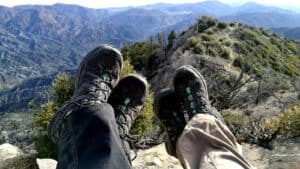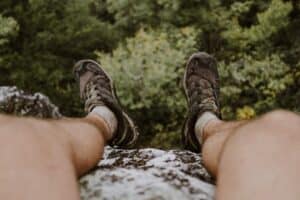Should hiking shoes fit tight? I’ve pondered over this too. It’s a common dilemma for outdoor enthusiasts. In this article, we’ll dive into the nitty-gritty of hiking shoe fit.
Should they be tight? Or should there be some wiggle room? I’ll be sharing insights from my years of hiking experience. We’ll also tap into expert advice to get a well-rounded view.
We’ll debunk some common myths and misconceptions about hiking shoe fit. By the end of this read, you’ll be equipped with the knowledge to choose the perfect hiking shoes. So, let’s get started on this exciting journey.
Importance of Proper Hiking Shoe Fit

Understanding the importance of a proper hiking shoe fit is paramount. With my years of hiking experience and continuous learning from experts, I’ve uncovered that ill-fitted hiking shoes can lead to discomfort, injuries, reduced performance, and ultimately ruin your hike.
Firstly, the wrong shoe fit can contribute to painful blisters. Ill-fitting shoes often rub against your skin and cause blisters that can make each step on your hike a painful ordeal.
Painful foot conditions, such as bunions and hammertoes, may also develop from constantly wearing tight-fitting shoes. These conditions occur when the toes are pushed out of alignment from the pressure of wearing shoes that don’t fit well. This pain and discomfort may discourage you from taking part in future hiking adventures.
Inappropriate shoe fit doesn’t only lead to pain and discomfort. It can also reduce your hiking performance significantly. Hiking requires a strong foothold and balance that only well-fitting boots can provide. Shoes that are too loose or tight can affect your balance, making it challenging to navigate through rocky trails or slippery surfaces.
Notably, a poorly-fitted hiking shoe can increase the risk of injuries like sprained ankles and stress fractures by altering the natural biomechanics of your walk or hike. Understand that hiking involves various terrains which demand flexibility, agility, and strength. Your shoes should support these needs rather than hampering them.
Walking in ill-sized shoes can generate unnecessary tension in the calves and hamstrings, leading to leg and knee problems. Prevention is better than cure, right? So it’s essential that you find hiking shoes that fit correctly to avoid these potential consequences.
When it comes to choosing the perfect hiking shoes, consider the fit carefully. With the correct fit, you’ll not only be comfortable but also prevent potential injuries and other foot problems that can ruin your hiking experience.
The Case for a Tight Fit
You might be wondering, why should hiking shoes fit tight in the first place? Isn’t comfort the ultimate goal? While comfort is crucial, it’s important to distinguish between what feels comfortable immediately and what will ensure long-term comfort and safety during your hike.
The theory behind a tighter fit primarily revolves around support and stability. When I say tight, I don’t mean uncomfortably squeezing your foot to the point it cuts off circulation! I’m talking about a snug fit that cradles your foot securely.
Here’s the real kicker: a good hiking shoe should fit like a glove – secure without constricting, stable without being unwieldy.
There a few reasons why a tighter fit is better for hiking shoes:
- Reduced movement inside the shoe – A tighter fit means less room for your foot to slide around inside. This cuts down on the friction that causes painful blisters and calluses.
- Improved stability on uneven terrain – Tight-fitting shoes provide better grip and traction, reducing the risk of slips and falls. They also offer more support to your ankles, decreasing the likelihood of sprains and other injuries.
- Enhanced control and balance – In snug shoes, you have a better feel of the ground beneath you. This translates into improved control and balance, especially on difficult or steep trails.
When picking out your next pair of hiking shoes, consider opting for a design that is secure, stable, and offers a snug fit. Of course, it’s essential that any tightness does not result in pain or discomfort; uncomfortable shoes can ruin your hike and potentially lead to long-term foot problems. Always prioritize proper fit and comfort while keeping these points in mind.
Benefits of a Tight-Fitting Hiking Shoe

When you’re hitting the trails, one major plus point of sporting tight fitting hiking shoes is improved foot stabilization. With a snug fit, foot movement inside the shoe is minimized. This reduced sliding and rubbing can help eliminate those nasty blisters that plague so many hikers.
Next, heightened terrain control is another benefit worth shouting about. Hiking often involves traversing uneven, unpredictable terrains. A tight fit provides a better shoe to foot connection, offering you enhanced stability and balance. Trust me, you wouldn’t want your foot slipping inside your shoe while you’re trying to negotiate a steep hill or rocky path.
Last but certainly not least, tight-fitting shoes increase proprioception. That’s a fancy term for your brain’s awareness of your body and its positioning. With a snug shoe fit, your feet send clearer signals to your brain about what’s underfoot. Whether it’s a slippery rock or a deep puddle, your brain gets an accurate snapshot, allowing for quick, safer foot placements.
It’s important to note here that a “tight fit” should not be confused with “too small” or “uncomfortably tight”. A tight-fitting shoe offers support and slightly hugs your foot, but should not cut off circulation or cause pain. If you feel discomfort, it’s a sign that the shoe might not be right for you. Remember, while a tighter fit has its advantages, comfort should be your main priority. The perfect hiking shoe feels snug, not strained.
Bear in mind though, everyone’s feet are unique, and what works for one person might not work for another. It’s always a great idea to try out multiple sizes and styles before settling on the perfect hiking shoe for your feet.
Is a Loose Fit Okay?
Let’s tackle the opposite end of the spectrum. Is a loose fitting hiking shoe a good alternative? The short answer is, it’s not recommended. Loose shoes lack the necessary support and can negatively impact your hiking experience. But let’s dive a bit deeper into why this might be the case.
Hiking terrain is often diverse and unpredictable; you’ll encounter rocks, slippery slopes, muddy trails, etc. A loose shoe increases the chances of your foot moving around inside, which in turn can cause blisters. Your foot sliding about in a loose shoe is one of the most common causes of blisters on a hike. When a shoe is too loose, the foot moves but the shoe doesn’t. This causes friction which leads directly to discomfort, blisters and potentially more serious foot conditions.
Another issue with loose shoes is the lack of support. Hiking boots need to provide strong support, especially around the ankle area. The uneven terrain of trails put extra pressure on your ankles. Loose shoes cannot provide this necessary support and leave your ankles at a greater risk of injury. A twisted ankle or worse, a sprained ankle, can be a likely result of wearing loose shoes while hiking.
Finally, the reduced immediate control you have over your footsteps and overall movement is another significant downside of loose shoes. Immediate control is particularly vital when you’re encountered with obstacles or steep terrains during your hike. Without it, you’ll have more difficulty navigating these challenges and be more prone to slipping or tripping.
Loosely fitted shoes have their place in the fashion world, they’re typically comfortable and easy to slip on. However, hiking is not the time nor place for such shoes. We’re talking about safety, efficiency and comfort during physically demanding activities, and loosely fitted shoes simply do not check those boxes.
Now that we’ve covered tight fittings and loose fittings, it’s time to delve into the balance between the two.
How to Achieve the Perfect Fit

Having had my fair share of hiking mishaps due to ill-fitting shoes, I’ve learned that achieving a perfect fit is more art than science. The balance between snug and too tight is crucial – you don’t want your hiking shoes to be loose, but neither should they be uncomfortably tight. Here are a few pointers I’ve gathered over the years.
First and foremost, size matters. It’s not just about the length of your foot, but also its width and volume. I recommend getting your foot measured professionally for an accurate size. This is especially important if it’s been a few years since your last fitting, as our feet do change over time.
Different brands and styles fit differently, so try out various hiking shoes before settling on one. Keep in mind the terrain and weather conditions you usually hike in – these will affect the type of hiking shoes that best fit your needs.
When trying on hiking shoes, do it later in the day when your feet are at their biggest – yes, our feet swell slightly as the day progresses. Also, don’t forget to try them on with the same type of socks you’ll be wearing on your hikes.
Bear in mind that there should be some wiggle room for your toes. Your heel should be secure, with no slipping as you walk. There should be no uncomfortable pressure points. Remember, hiking shoes that fit well are snug, not tight.
Lastly, be patient. It may take some time to find the perfect fit. Remember, your feet are the foundation of your hiking experience. They deserve the attention and effort.
Next, let’s delve into how to break in your newly found perfect-fitting hiking shoes to reap their full benefits.
Expert Advice on Hiking Shoe Fit
As an outdoor enthusiast with years of hiking under my belt, I can tell you finding the perfect fitting hiking shoe takes some time, patience, and knowledge. Your shoe size may vary across different brands, and that’s completely normal. Just like clothing, there’s no universal sizing when it comes to shoes. Trying on different brands is key to finding the perfect fit.
It’s been my experience that the best time to try on hiking shoes is later in the day. This might catch a few folks off guard, but our feet tend to expand throughout a day of standing and walking. When you try on shoes later in the day, you’re making sure that your shoes will remain comfortable even as your feet naturally expand. Trust me on this; it’s an important consideration.
Also, contrary to what many might believe, a perfect hiking shoe is one that leaves you some room to wiggle your toes. I’ve encountered numerous hikers who have bought their hiking shoes too tight, thinking that it’s better to have a snug fit. However, you should remember your toes need some room. A shoe that fits perfectly in the store may feel too tight after some miles on the trail. Your feet need breathing space, don’t forget this.
Finally, patience is crucial. Don’t buy the first pair that feels ok. Spend some time trying a variety. Seek professional advice too, if possible, as experts in outdoor gear stores can give individualized advice based on your foot’s shape and your hiking preferences.
Old school leather boots, rugged trail runners, or something else entirely, what your perfect hiking shoe looks like can only be answered by you. It’s your journey. Find your pair. But remember, they should fit you like a glove. Now, let’s explore how to break in these perfect fit shoes.
Common Myths and Misconceptions

Let’s dive right into some of the Common Myths and Misconceptions about hiking shoe fit that I’ve come across during my years of experience. Exposing these fallacies isn’t just a fun exercise – it’s a step towards understanding the ultimate pursuit of a perfect fit.
One myth that appears often is the belief that hiking shoes should fit tightly to prevent the foot from sliding around. This isn’t quite true. While a secure fit is indeed important, a too-tight shoe can create discomfort, leading to blisters and foot pain. You should instead aim for shoes that offer a snug but comfortable fit – enough room for your foot to move without being excessive.
Another frequent misconception I’ve heard is that the heavier the hiking shoe, the better. It’s based on the idea that a heavier boot offers support, protection, and durability. But what’s crucial is that these qualities don’t necessarily depend on the weight of the shoe. Lighter models can offer equal, or even superior, support and protection. It all comes down to design and materials.
Do not fall for the myth that you should buy hiking boots even if they are one size too large. Some folks insist that you need the extra room for thick socks or swollen feet. Fact of the matter is, too large a size may lead to unreliable foot control, discomfort, and accidents.
Last but not least, it’s a misconception that all shoes within the same size are created equal. Sizes vary between brands, styles and even individual models. It’s not unusual for someone to wear a size 8 in one brand but a size 9 in another. Always remember: patience and experimentation are key in the quest for a perfect fit.
In our next section, we will delve into the world of breaking in your newly found perfect-fitting hiking shoes. But remember: myths and misconceptions can muddy the waters. Stick to the facts, test out different shoes and be patient. Your feet will thank you.
Conclusion
So, we’ve busted some myths and cleared the air on how hiking shoes should fit. Remember, they should be snug, not tight. It’s all about comfort and preventing foot pain. Don’t be fooled into thinking that heavier shoes offer more support and durability. Lighter models can often outperform their bulkier counterparts.
Avoid the mistake of buying a size too large. It’s a surefire way to discomfort and unreliable foot control. And let’s not forget that shoe sizes aren’t universal. They vary between brands, styles, and models. So, don’t rush the process. Patience and experimentation are your allies in the quest for the perfect fit.
Next up, we’ll delve into the art of breaking in your perfectly fitting hiking shoes. Stay tuned!


